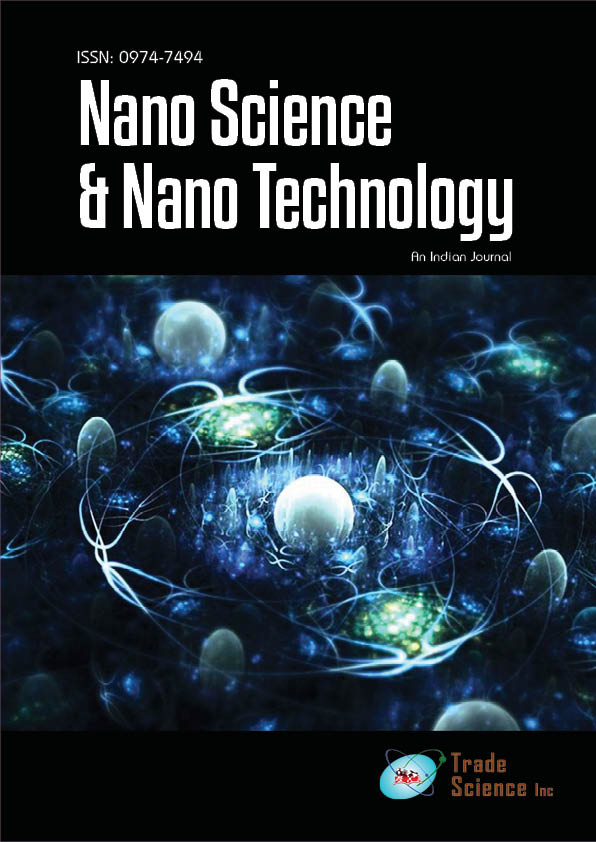Current opinion
, Volume: 16( 4) DOI: 10.37532/ 0974-7419.2022.16(4).157Nanotechnology Cancer Therapy
Citation: Emily Wilson. Nanotechnology Cancer Therapy. Nano Tech Nano Sci Ind J. 2022; 16(4):157
Abstract
In the future decades, cancer is anticipated to overtake other significant causes of death as one of the world's top causes of morbidity and mortality. Despite the developments and in-depth study of new methods, the only available treatments at this time are surgery, radiation, chemotherapy, and immunotherapy. In most cases, treatment failure is attributable to pharmacologic, toxicological, or drug resistance problems
Introduction
In the future decades, cancer is anticipated to overtake other significant causes of death as one of the world's top causes of morbidity and mortality. Despite the developments and in-depth study of new methods, the only available treatments at this time are surgery, radiation, chemotherapy, and immunotherapy. In most cases, treatment failure is attributable to pharmacologic, toxicological, or drug resistance problems.
By providing superior pharmacokinetic features, prolonged blood circulation time, cellular uptake, and volume of distribution, and half-life, Nano carrier use, on the other hand, results in increased therapeutic index and tumour tissue concentrations of the drugs and can improve the efficacy of currently used regimens. These are key factors for an improved therapeutic window and subsequent clinical success
Presently, scientists' capacity to translate promising molecular findings into advantages for cancer patients is constrained. The science and engineering of controlling matter at the molecular level to produce devices with novel chemical, physical, and/or biological properties is known as nanotechnology. Nanotechnology can provide technical control and tools to enable the development of new diagnostics, therapeutics, and preventative measures that keep up with the current explosion in knowledge
The way we identify and treat cancer may drastically change as a result of nanotechnology. While the ability to industrialize technology at this scale has only lately (around 1980s) been created by scientists and engineers, there has been significant progress in the development of Nano-based cancer medicines and diagnostics.
The use of substances, functionalized structures, tools, or systems at the atomic, molecular, or macromolecular scales is known as nanotechnology. These unique and particular physical properties of matter exist at these length scales, roughly the 1-100 nanometer range, as specified by the U.S. National Nanotechnology Initiative (NNI), and can be easily modified for a desired use or effect. Nanoscale structure can also be employed independently or combined with bigger material elements, systems, and structures
Benefits:
Devices at the nanoscale are 100–10,000 times smaller than human cells. They resemble huge biological molecules (sometimes referred to as "biomolecules") like enzymes and receptors in size. As an illustration, the diameter of hemoglobin, the oxygen-carrying molecule in red blood cells, is about 5 nanometers. Most cells can be easily penetrated by nanoscale objects less than 50 nanometers, but objects smaller than 20 nanometers can exit blood arteries as they circulate through the body. Nanoscale devices can easily interact with biomolecules both outside and inside of cells due to their small size. They have the ability to identify sickness and administer treatment in previously unheard-of ways since they have access to so many different parts of the body.
An efficient cancer medicine delivery should result in substantial tumour accumulation while sparing the nearby healthy tissues. The Enhanced Permeability and Retention [EPR] effect, which refers to the passive localization of many medicines and drug carriers as a result of their extravasation through leaky vasculature, is extremely effective for tumours. A network of blood arteries must grow swiftly to fulfil the tumour cells' demand for oxygen and nutrients as the tumour mass increases quickly. Big pores (40 nm to 1 um) are created in the vessel walls as a result of this aberrant and poorly controlled vessel growth (also known as angiogenesis), which allows relatively large nanoparticles to extravasate into tumour masses. The lack of a functioning lymphatic system in a rapidly expanding tumour mass limits the elimination of these nanoparticles, which increases the buildup.
Nanoparticles Comprised of Polymers
The two main types of polymers that are utilized to create nanoparticles are natural polymers and synthetic polymers. Heparin, dextran, albumin, gelatin, alginate, collagen, and chitosan are just a few examples of natural polymers that have undergone extensive research. Polyethylene glycol (PEG), polyglutamic acid (PGA), polylactic acid (PLA), polycarprolactone (PCL), and N-(2- hydroxypropyl)-methacrylamide copolymer (HPMA) are examples of synthetic polymers that have been used in various applications. The ability to be functionalized, biodegradability, and biocompatibility are prerequisites for such polymers.
Several review publications have provided an overview of the creation of polymeric nanoparticles. A hydrophobic core that contains anticancer drugs and a hydrophilic shell that stabilizes the nanoparticle in water settings make up the majority of polymeric nanoparticles.
Nanoparticles in a Liposome
Liposomes are spherical, self-assembling particles having a phospholipid bilayer-based membrane. Depending on the method of preparation, liposome size can range from 25 nm to 10 m. Since Bangham originally made his discovery, they have been researched as potential medication delivery systems. Bellare, et al. has studied the process of creating liposomal nanoparticles. The short blood circulation period of unmodified liposome-based drug delivery systems places them at a disadvantage. This is mostly caused by the reticuloendothelial system's macrophages' rapid clearance of liposomes.
Current Treatments:
The application of nanotechnology in cancer diagnosis and treatment is still mostly in its infancy. Though several Nano-based treatments are currently undergoing clinical trials, there are already a number of medications based on Nano carriers available. The use of precisely tailored materials to create novel therapies and technologies that could increase the efficacy and delivery of treatments while reducing toxicity is one example of how nanotechnology is being applied to medicine. As a result, the use of nanotechnology in the treatment, detection, and prevention of cancer can result in several improvements. The first cancer medications based on nanotechnology have already been approved and are available on the market, including Doxil® and Abraxane

